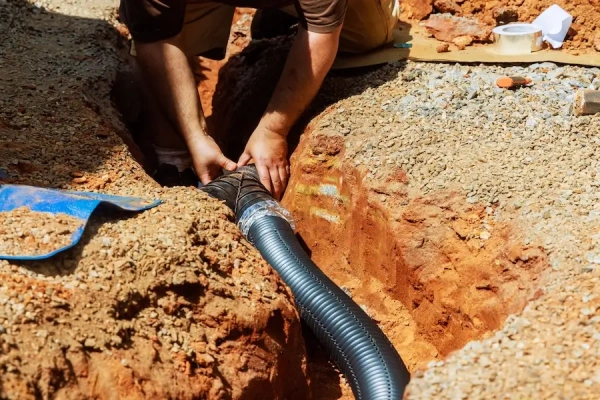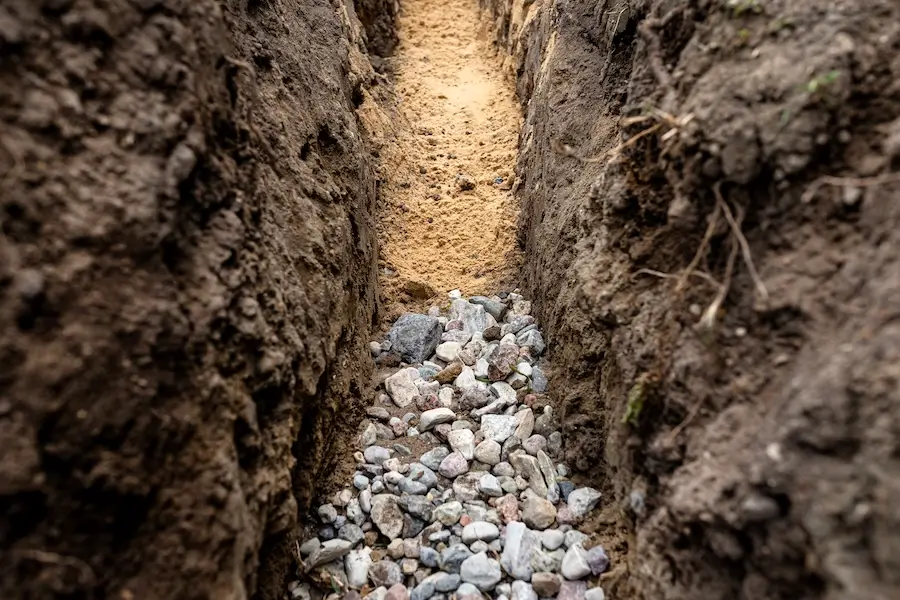
Whether you’re building a new home, renovating one from the ground up, or even simply replacing your old, damaged drains, you’ll likely hear experts talking about weeping tile installation concerning foundation drainage.
This type of system plays a key role in protecting your home, especially if you have a basement. A properly installed weep system by a trusted plumbing expert can help prevent flooding and other water damage. To learn more about how weeping tile drainage works and explore other effective drainage solutions, check out our helpful guide below.
What Is a Weeping Tile?
A weeping tile, or weeping tile system, is a pipe with ‘weep’ holes. These drains are installed under a basement, up to 10 feet below the surface, or in trenches surrounding a property. They’re designed to drain water away from your home, so you don’t end up needing to perform costly foundation-related repairs due to flooding.
How Does a Weeping Tile Work?
Weeping tile drainpipes are typically made of corrugated plastic and feature a sponge-like design that allows them to absorb water from beneath or around your property. The water is then delivered to your sump pump, which discharges it away from your home.
Weeping tile installation is a standard part of basement waterproofing. After a trusted plumbing professional installs a weeping tile under your basement, it’s filled with gravel and soil before the pipes are connected to your underground sump pit. This is usually on or near your property. Once in place, the weeping tile drainage pipes are covered with concrete.
Benefits of a Weeping Tile System
If you’re in the process of building, renovating, or performing drain repairs, you’ll likely be thinking about basement waterproofing and the pros and cons of installing a weeping tile system. Ask any experienced plumber in Canada, and they’ll likely share some of these benefits:
- Prevents basement flooding: Weeping tiles channel groundwater away from your home, preventing it from seeping into your basement and causing flooding and damage.
- Offers foundation protection: Water building up around a foundation can cause structural damage, shifting, and cracks. Weeping tile systems protect your foundation’s integrity by reducing hydrostatic pressure (water pressure against a surface).
- Reduces mould and mildew: Weeping tiles keep water out of your basement and home, maintaining a healthier environment that is less prone to mould and mildew growth.
- Promotes sump pump efficiency: Weeping tiles work with your sump pump to prevent water from pooling under your home.
- Improves soil drainage: If you use a weeping tile around your home’s exterior, you may experience less surface water in your landscaping after heavy rainfall.
- Increases home value: Potential home buyers value properties with professional basement waterproofing.
Weeping Tile vs. French Drain

When researching basement waterproofing options, you’ll likely encounter information about French drains. In fact, you might even see the terms ‘weeping tile’ and ‘French drain’ used interchangeably, along with ‘interior’ and ‘exterior’ weeping tiles.
As we now know, a weeping tile is a drainage system installed beneath your basement. They are typically located below ground level and installed on a sloping surface. While similar, a French drain, also known as exterior weeping tile, differs in its function, application, and placement.
Interior vs. Exterior Weeping Tile Differences
- Location: An interior weeping tile is installed beneath the basement floor, adjacent to the interior perimeter. In contrast, an exterior weeping tile is installed around the foundation's exterior.
- Use: An interior weeping tile system is generally more suitable for your property if you are retrofitting due to water problems and already have a finished basement. If you have a new build or will be performing significant renovations that involve extensive digging, plumbers will typically recommend exterior weeping tiles.
- Waterproofing function: An interior weeping tile directs water entering your basement to your sump pump, effectively managing the flow of water. An exterior weeping tile stops it from coming through your foundation in the first place.
- Installation difficulty: Interior weeping tiles are typically straightforward to install because they don’t require disturbing any landscaping. Exterior weeping tiles can be more involved, as their installation requires excavation and may even involve exposing your property’s foundation.
- Sump pump use: Interior weeping tiles utilize a sump pump to discharge water, whereas an exterior weeping tile or French drain can drain naturally, such as through gravity-fed flow to a storm drain, and sometimes without a sump.
Contact Mr. Rooter Plumbing® for Weeping Tile Installation, Maintenance, and Repairs
Whether you need to install a weeping tile or have a problem with your basement waterproofing system, such as a clogged weeping tile, the licensed and insured service professionals at Mr. Rooter Plumbing® are here to help. We can assist with all your weeping tile installation, maintenance, and repair needs. Call us today or request a job estimate online.

